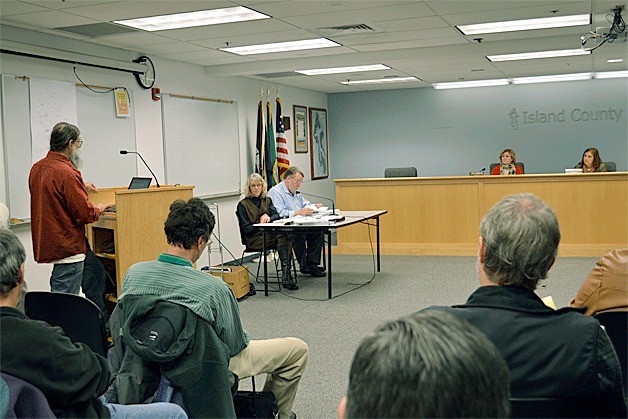After nearly three hours of public comment in Coupeville last week, Island County Commissioners are still not ready to make a decision on a proposed Shoreline Master Program update.
Commissioners continued the second of two public hearings to 2 p.m. Tuesday, Nov. 27, after the News-Times went to press, to give citizens one last chance to weigh in on the issue and to give themselves and county staff time to sort through the mountain of suggestions brought before them.
Public access — a topic that has been of particular concern to residents — continued to dominate most of the comments at the Nov. 19 hearing.
County Planning Director Bob Pederson told the board staff had looked at all the criteria and identified 11 more potential public access sites.
Several residents said it’s not fair to single out owners of waterfront property to add more access when the county isn’t even sure how many access points currently exist or where they are located.
“There is a book by Washington State University Extension (“Getting to the Water’s Edge”) that lists all the access points in Island County,” said Coupeville resident Gary Wray. “There are 57 public access points on Whidbey Island and 10 on Camano.”
“That’s one access point for every four miles of shoreline. But if we can’t maintain what we’ve already got, why do we need more?”
“If I had 67 apple trees and I wasn’t maintaining them well or caring for them, would I plant 11 more trees, or would I take care of the 67 I already have?” asked West Beach Road resident Craig McKenzie.
Jeff Lauderdale, who ran against Commissioner Helen Price Johnson in the recent election, said it’s too late for the state to rectify the mistake it made when it sold waterfront property to residents years ago.
“In my world, you don’t get a do-over when you sell something,” he said. “You’re asking people to give up the ‘private’ portion of their property. You need to really think about that.”
“There aren’t a lot of entities speaking up for the property owners’ rights,” said Jason Joiner, head of the Whidbey Island Association of Realtors. “We need to protect the pursuit of the American dream.”
“There may be 67 public access points, but they are not evenly distributed,” countered Sarah Schmidt, of Coupeville. “We’re not always talking big access. It can be small, perhaps space where three or four vehicles can park.”
Aquaculture proved to be the other hot topic Monday evening.
“The impact of fish farming on wild fish is just too negative,” said Steve Erickson of Whidbey Environmental Action Network, who cited several sources regarding sea lice infestation and the hazard it could pose to native fish populations. “A secondary sea lice infestation can reach up to 75 kilometers. There is nowhere a net pen on Whidbey Island can be 75 kilometers away.”
The impact of bio deposits from net pens as well as the potential escape of non-native species was also of concern to residents, who cited instances of Atlantic salmon being found as far north as Cook Inlet, Alaska, near Anchorage.
They suggested restricting any potential fish farming to only native species.
Still others asked commissioners to recognize the difference between fish farming and shellfish farming.
“Shellfish aquaculture relies on a healthy marine environment,” said Diane Taylor of Taylor Shellfish. “It can actually restore and upgrade the environment and help diversify the local economy.”
“If you can grow shellfish, something right is going on,” said Ian Jefferds of Penn Cove Shellfish.
In the end, the commissioners continued the hearing.
“That will be the last day of public comment so we can move forward with our deliberations,” said board chairwoman Helen Price Johnson.
Once the commissioners have agreed on the program, it will be sent to the state Department of Ecology, which can hold its own public hearings on the matter before requesting local government to respond to its comments.



